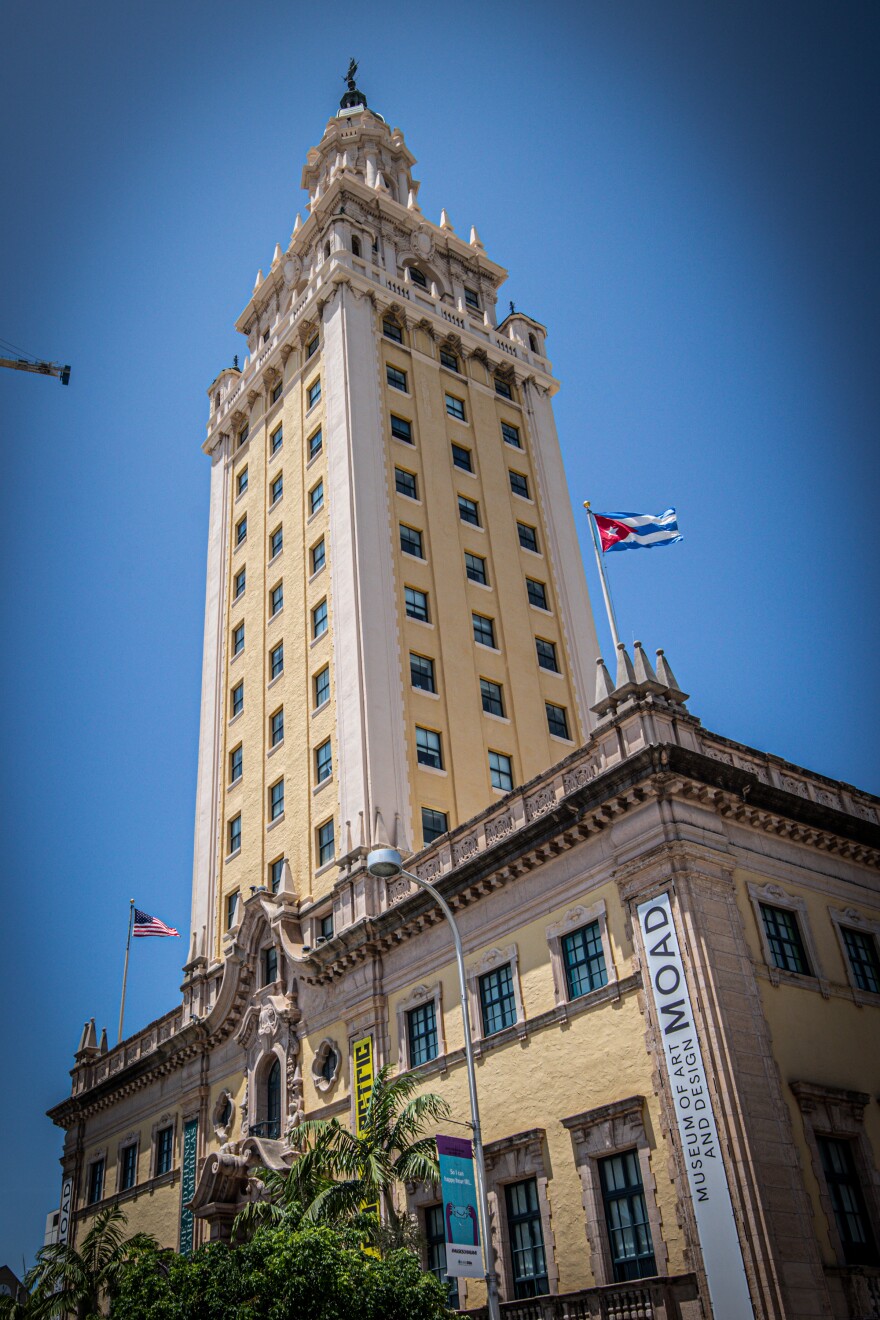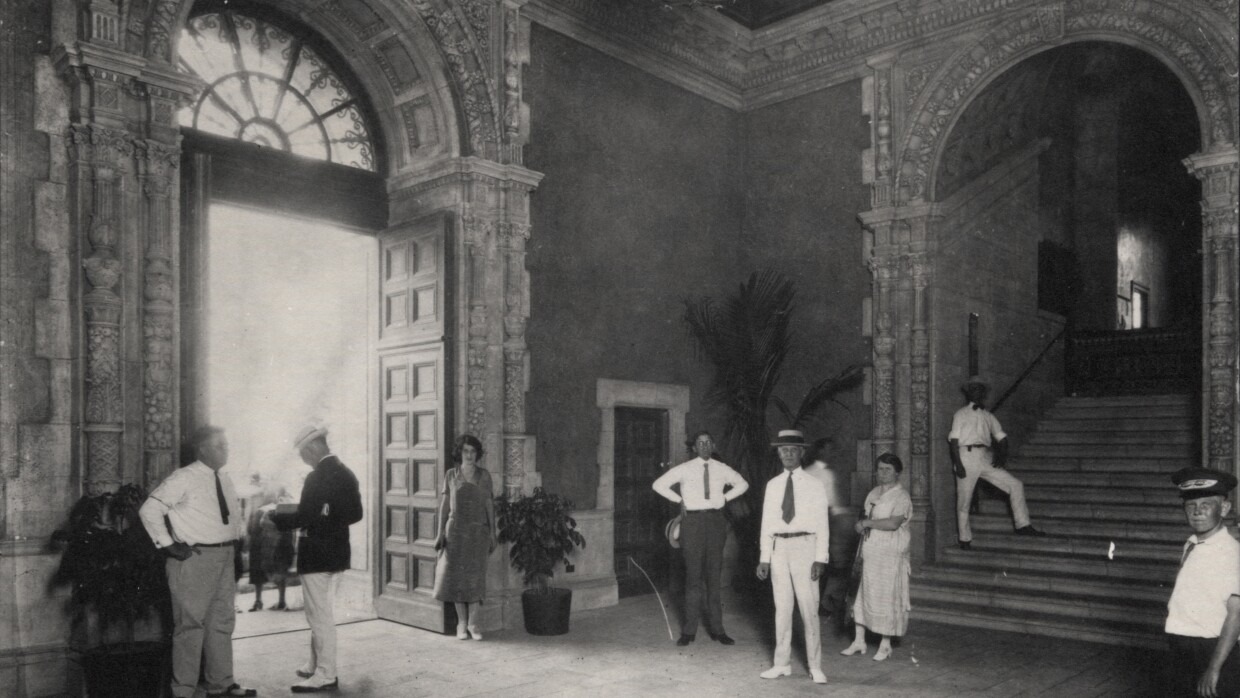
From Palm Beach County to Miami-Dade, 11 cities are celebrating their centennials in 2025 and 2026. WLRN News' series "History We Call Home" spotlights the moments, ideas and people that made these cities part of our community's fabric over the past century.
For nearly a century, Miami’s Freedom Tower has stood as a silent witness to the city’s transformation — from a media hub to a sanctuary for refugees and now a living museum of cultural memory.
As it nears its 100th birthday, the building is preparing to tell its own story anew.
When it opened in 1925, the Freedom Tower was Miami’s tallest building — a skyscraper with Spanish and Mediterranean influences that housed The Miami Daily News and Metropolis, a newspaper led by former Ohio governor and former Congressman James Middleton Cox.
But the newspaper moved out three decades later, leaving the tower without a clear purpose.
That changed in the early 1960s when the federal government stepped in, leased the site and repurposed it into a processing center for hundreds of thousands of Cubans fleeing Fidel Castro’s communist regime between 1962 and 1974.
READ MORE: History We Call Home: How the Great Land Boom shaped South Florida 100 years ago
Many Cuban exiles referred to the building as El Refugio, meaning "the refuge."
“ So many people came through the Freedom Tower after giving up everything,” said Paul George, a resident Historian at History Miami Museum. “Coming over here penniless, they would get on their feet working hard, learning the language and would succeed in life. It's the quintessential success story for humanity.”
“To me, it’s like the Statue of Liberty. It should be there, as a symbol of freedom, as a symbol of American hospitality and concern for refugees.”Luis Serrano
Among those immigrants was Luis Serrano. He was 14 when he, his mother and sister arrived in Miami in 1967 through the Freedom Flights — a series of flights created to facilitate the emigration of Cuban refugees from the communist island to Miami in the 1960s and early 70s.
Upon their arrival, they were processed at the Freedom Tower through the federal Cuban Refugee Assistance Program. The initiative was created to help the 650,000 Cubans fleeing from the communist government led by Fidel Castro.

“To me, it’s like the Statue of Liberty,” Serrano said. “ It should be there, as a symbol of freedom, as a symbol of American hospitality and concern for refugees.”
Serrano went on to become a professional musician, earning degrees from Miami Dade College and Florida International University. He co-founded the group Los Miami Latin Boys, which later evolved into the Miami Sound Machine, with famed Cuban-American musician Emilio Estefan.
Serrano has also written short stories that include anecdotes from his life and a poetry book.
Centennial exhibits
As cities around South Florida celebrate their centennial anniversaries this year and the next, Miami Dade College, which acquired the Freedom Tower in 2005, is planning to open a series of centennial exhibits in September.
“We're going to be incredibly proud to be able to really tell the story of the Freedom Tower and its 100 years,” said Miami Dade College President Madeline Pumariega.
Among plans for the exhibits:
- Libertad ('Liberty'): It will feature a replica of the building during its time as a refugee center and spotlight the stories of Cuban exiles who came to South Florida in search of freedom.
- A dedication to the victims of communism.
- A spotlight on people who came through Operation Pedro Pan — which shaped the lives of a generation of Cuban-Americans. Between 1960 and 1962, the program airlifted more than 14,000 Cuban children from Havana to the U.S.
- La Pared de la Suerte ('The Wall of Luck'). It will recreate where people would get information about jobs like babysitting.
- A new research and archive center where community members can share documents and personal stories.
- North America’s first-ever FIFA exhibit. FIFA is the international governing body for soccer.
- The Knight Skylight Gallery. It will feature art exhibitions, multimedia installations and events that reflect Miami’s history and culture.

”It makes perfect sense that the community's college is also the college that's in charge of the Freedom Tower, of making sure that we shepherd the next 100 years of the Freedom Tower, and that we tell the story of the Freedom Tower, that we preserve the legacy for what it stands for, and the people who've made it the Freedom Tower,” Pumariega said.
Pumariega's own parents passed through the Freedom Tower.
“Coming into the Freedom Tower was this place where America opened its doors and provided refuge for them, whether it was [through] a piece of cheese, spam, peanut butter, or a coat,” Pumariega said.
Decades of neglect
After decades of neglect and disrepair, when the Cuban Refugee Assistance Program ended, the tower was rescued by Cuban American community leaders and donated to the MDC.
Today, it houses the Museum of Art and Design and MDC’s special collections, including the Cuban Legacy Gallery, the Kislak Center and the Exile Experience, which honors immigrant diasporas across the Americas. In 2008, the building was designated as a National Historic Landmark.
The Freedom Tower has also hosted the Miami Book Fair, Miami Film Festival, and Live Arts Miami.
To preserve the tower’s structure and design, it has been undergoing major construction and upgrades over the past three years. Including the improvement of the water and sewer infrastructure and expanding accessibility features to comply with the Americans with Disabilities Act.
The project was funded by $25 million in state money, $25 million from Miami Dade College and other private donations. MDC also received $5 million from the Knight Foundation in June.
READ MORE: A $25 million restoration highlights Freedom Tower’s centennial
“The Freedom Tower stands at the crossroads of Miami’s past, present and future,” said Maribel Pérez Wadsworth, president and CEO of Knight Foundation, in a statement announcing the gift. “With this gift, we are not only helping to preserve a landmark of profound historical significance but also ensuring that every Miamian can see themselves reflected in its exhibitions, programs and cultural expression.”
Renovations are expected to be completed in August, with the tower’s official reopening in September.
“The Freedom Tower was in dire need of repairs and maintenance so that it could reach its first 100 years in all its splendor, but also so that we could ensure that it would always remain standing for future generations,” said María Carla Chicuén, executive director of cultural affairs at Miami-Dade College, which oversees management of the tower.







